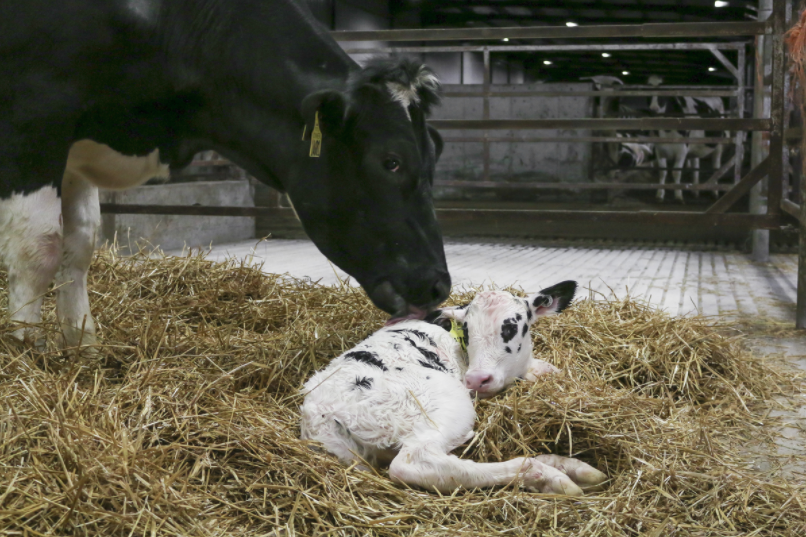While management of colostrum once it’s been harvested is extremely important, this attention will be useless if the quality of the colostrum coming out of the cow is not optimized. If you’re going to invest that much in proper colostrum management, you should ensure a high-quality product to work with.
Colostrum quality can vary widely and can be influenced by a variety of factors including breed, age, season of the year, the cow’s vaccination and disease history, volume produced and other factors. Colostrum quality, measured in immunoglobulin G (IgG) levels, can range from 10 milligrams per milliliter to more than 150 milligrams per milliliter. Colostrum over 50 milligrams per milliliter is considered high-quality from an IgG standpoint, but it should also be free of blood and other contaminants and have a standard plate count (bacterial levels) of less than 50,000 cells per milliliter. In order for these cleanliness levels to be attained, pooled colostrum should always be heat treated prior to use.
So what can producers do to impact the quality of the colostrum made before it exits the cow?
Target colostrogenesis
Cows go through a process called colostrogenesis prior to calving, which is the transfer of immunoglobulins (predominately IgG1) from the maternal circulation into the mammary gland. The onset of colostrogenesis is complex, but changes in hormones (decreasing progesterone and increasing estrogen) late in pregnancy are involved in the process. If higher-quality colostrum has more immunoglobulins, then it would make sense that cows with more immunoglobulins to transfer during colostrogenesis would make higher-quality colostrum.
Cows develop antibodies (which are immunoglobulins) by being exposed to foreign substances, including outside pathogens. Antibodies are produced by certain types of white blood cells (B-cells). Cows use antibodies to fight off outside disease pressure and reduce severity of disease. The B-cells that produce antibodies can survive for many years and be rapidly called upon to produce additional antibodies when future challenges occur. In that sense, the more disease pressure the cow is exposed to throughout her lifetime, the more B-cells and resulting antibodies available to fight off disease and to transfer to her calf through colostrum.
Vaccines boost antibodies
While natural exposures can create higher antibody levels, vaccines also induce antibody formation. Vaccination results in higher antibody levels for specific diseases that enhance disease resistance for the cow. These additional antibodies can also be transferred into the colostrum, resulting in higher-quality colostrum benefiting the health of the calf.
Antibodies persist for some time, with levels (measured as titers) dropping over time if the cow is not re-exposed to the specific antigen that produced the antibody. Booster vaccinations are used to re-expose the cow, thus increasing antibody production.
Timing of vaccination is important to take full advantage of colostrogenesis. The onset of colostrogenesis begins five to eight weeks prior to calving, with large amounts of immunoglobulin transfer occurring two to three weeks prior to calving. A cow doesn’t immediately start producing antibodies the moment a vaccine is administered. First the cow’s immune system must recognize the antigen, then the specific B-cells must propagate and start making antibodies. That process takes around a week to get going, with significant antibody production occurring two or three weeks later.
With that in mind, target first-time vaccinations (heifers) eight to 16 weeks prior to calving with a booster three to four weeks later. (This depends on which vaccine is used. Follow label directions and consult with your veterinarian.) This should provide large amounts of antibodies in the blood available for transfer to colostrum. In subsequent years, a booster at eight weeks prior to calving should suffice.
Scours control
One of the indicators of adequate colostrum management is the health of the calves consuming the colostrum. If the incidence of scours in the calf barn is relatively low, then it’s likely your calf team is doing a good job of both controlling pathogens and bolstering immunity inside the calf with high-quality colostrum.
Vaccinating cows prior to calving can help make your employees’ jobs easier by improving colostrum quality. A 2021 study showed the effectiveness of vaccinating cows with a scours vaccine. The study was carried out in a commercial herd where cows were vaccinated with a scours vaccine (Scour Bos) eight to nine weeks prior to calving and again four weeks after the initial vaccination.
Results showed that animals vaccinated with a scours vaccine had significantly higher colostral antibody titers to bovine coronavirus and bovine rotavirus than unvaccinated animals. This means calves consuming this higher-antibody colostrum will have a greater chance of providing passive immunity and fighting off disease pressures after birth.
Following the processes to boost colostrum development inside the cow should result in better-quality colostrum and more adequate immune transfer to the calf. Establishing adequate antibody levels to transfer to the colostrum during colostrogenesis will help improve colostrum quality. The proper harvest, storage and administration of the colostrum will help ensure calves have the appropriate resources to build immunity and fend off harmful pathogens. The management of colostrum once it’s outside the cow will be the topic of our next article in this two-part series. ![]()
PHOTO: Staff photo.
References omitted but are available upon request. Click here to email an editor.
This article is the first article in a two-part series.
-
David Prentice
- Veterinarian
- Elanco Animal Health
- Email David Prentice







